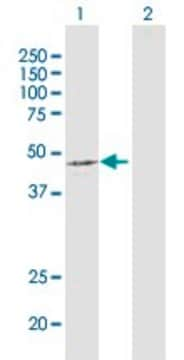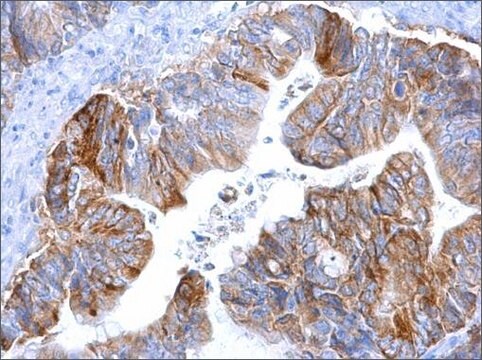ABS2082
Anti-PDH
serum, from rabbit
Synonym(s):
Pyruvate dehydrogenase E1 component subunit alpha, somatic form, mitochondrial, PDHE1-A type I, Pyruvate dehydrogenase E1 component subunit beta, mitochondrial, PDHE1-B
About This Item
Recommended Products
biological source
rabbit
Quality Level
antibody form
serum
antibody product type
primary antibodies
clone
polyclonal
species reactivity
mouse, human
technique(s)
immunocytochemistry: suitable
immunofluorescence: suitable
immunohistochemistry: suitable
western blot: suitable
shipped in
dry ice
target post-translational modification
unmodified
Gene Information
human ... PDHA1(5160)
General description
Specificity
Immunogen
Application
Western Blotting Analysis: A 1:4,000 dilution from a representative lot detected endogenous PDH alpha and beta subunits in 50 µg of mouse liver tissue lysate as well as 50 ng of purified recombinant human PDH alpha and beta subunits (Courtesy of Professor Mulchand S. Patel, Ph.D., SUNY Buffalo, NY, U.S.A).
Immunofluorescence Analysis: A representative lot immunostained oocytes in Bouins fluid-fixed, paraffin-embedded sections of mouse ovaries. A loss of oocyte PDH immunostaining was observed in ovaries from transgenic mice carrying homozygous floxed Pdha1 alleles and zona pellucida protein-3 (Zp3) promoter-driven Cre expression to allow oocyte-specific Pdha1 deletion (Johnson, M.T., et al. (2007). Biol Reprod. 77(1):2-8)
Immunohistochemistry Analysis: A representative lot immunostained neural cells in paraplast-embedded brain microtome sections from Bouins fluid-perfused mice. A marked increase in cells with low PDH immunostaining was observed in brain from transgenic mice carrying heterozygous floxed Pdha1 allele and nestin promoter-driven Cre expression to allow brain tissue-specific Pdha1 deletion (Pliss, L., et al. (2004). Neurochem. 91(5):1082-1091).
Western Blotting Analysis: A representative lot detected reduced level of PDH alpha & beta subunits in brain, but not liver, tissue from transgenic mice carrying heterozygous floxed Pdha1 allele and nestin promoter-driven Cre expression to allow brain tissue-specific Pdha1 deletion (Pliss, L., et al. (2004). Neurochem. 91(5):1082-1091).
Signaling
Quality
Western Blotting Analysis: A 1:2,000 dilution of this antibody detected PDH alpha and beta subunits in 10 µg of human whole brain tissue lysate.
Target description
Physical form
Storage and Stability
Handling Recommendations: Upon receipt and prior to removing the cap, centrifuge the vial and gently mix the solution. Aliquot into microcentrifuge tubes and store at -20°C. Avoid repeated freeze/thaw cycles, which may damage IgG and affect product performance.
Other Notes
Disclaimer
Not finding the right product?
Try our Product Selector Tool.
Storage Class Code
12 - Non Combustible Liquids
WGK
WGK 1
Certificates of Analysis (COA)
Search for Certificates of Analysis (COA) by entering the products Lot/Batch Number. Lot and Batch Numbers can be found on a product’s label following the words ‘Lot’ or ‘Batch’.
Already Own This Product?
Find documentation for the products that you have recently purchased in the Document Library.
Our team of scientists has experience in all areas of research including Life Science, Material Science, Chemical Synthesis, Chromatography, Analytical and many others.
Contact Technical Service








